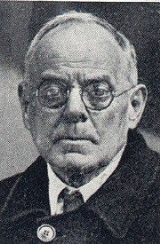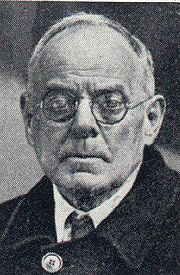
Algernon Sidney Crapsey
Encyclopedia

Priest
A priest is a person authorized to perform the sacred rites of a religion, especially as a mediatory agent between humans and deities. They also have the authority or power to administer religious rites; in particular, rites of sacrifice to, and propitiation of, a deity or deities...
and father of poet
Poet
A poet is a person who writes poetry. A poet's work can be literal, meaning that his work is derived from a specific event, or metaphorical, meaning that his work can take on many meanings and forms. Poets have existed since antiquity, in nearly all languages, and have produced works that vary...
Adelaide Crapsey
Adelaide Crapsey
Adelaide Crapsey was an American poet. Born in Brooklyn, New York, she was raised in Rochester, New York, daughter of Episcopal priest Algernon Sidney Crapsey, who had been transferred from New York City to Rochester, and Adelaide T...
. In 1879, he was transferred from Trinity Church
Trinity Church, New York
Trinity Church at 79 Broadway, Lower Manhattan, is a historic, active parish church in the Episcopal Diocese of New York...
in New York City
New York City
New York is the most populous city in the United States and the center of the New York Metropolitan Area, one of the most populous metropolitan areas in the world. New York exerts a significant impact upon global commerce, finance, media, art, fashion, research, technology, education, and...
to Rochester, New York
Rochester, New York
Rochester is a city in Monroe County, New York, south of Lake Ontario in the United States. Known as The World's Image Centre, it was also once known as The Flour City, and more recently as The Flower City...
to become the pastor of St. Andrew’s Episcopal Church on Averill Avenue.
Crapsey was an ardent supporter of the Social Gospel movement and developed a national reputation for eloquent lectures that inspired social ideals. His church was soon among the most well attended in Rochester.
In 1906, his progressive views led him to run afoul of orthodox Church authorities when he delivered a lecture stressing the humanity of Jesus
Jesus
Jesus of Nazareth , commonly referred to as Jesus Christ or simply as Jesus or Christ, is the central figure of Christianity...
, a notion contrary to the literal interpretation of the Scriptures
Books of the Bible
The Books of the Bible are listed differently in the canons of Judaism and the Catholic, Protestant, Greek Orthodox, Slavonic Orthodox, Georgian, Armenian Apostolic, Syriac and Ethiopian churches, although there is substantial overlap. A table comparing the canons of some of these traditions...
. This culminated in an ecclesiastical proceeding for heresy
Heresy
Heresy is a controversial or novel change to a system of beliefs, especially a religion, that conflicts with established dogma. It is distinct from apostasy, which is the formal denunciation of one's religion, principles or cause, and blasphemy, which is irreverence toward religion...
that same year held in Batavia, New York which drew national attention. Despite local and national support, Crapsey was the victim of a political trial aimed at discouraging reformers and freethinkers. He was found guilty and stripped of his ministry.
Significantly, Crapsey was accompanied to the proceedings by his daughter Adelaide rather than his wife, Adelaide T. Crapsey
Adelaide T. Crapsey
Adelaide Trowbridge Crapsey was the wife of American Episcopal priest and social reformer Algernon Sidney Crapsey and mother of American poet Adelaide Crapsey....
. Moreover, rather than bitterly renouncing the church, the family remained faithful members, and Crapsey continued to lecture, write, and foster social projects until his death.
In addition to Adelaide, his family included eight other children: Philip, Emily, Paul, Rachel, Algernon Jr., Ruth, Marie, and Arthur. Two of the children died fairly young—one from brucellosis
Brucellosis
Brucellosis, also called Bang's disease, Crimean fever, Gibraltar fever, Malta fever, Maltese fever, Mediterranean fever, rock fever, or undulant fever, is a highly contagious zoonosis caused by ingestion of unsterilized milk or meat from infected animals or close contact with their secretions...
, the other from appendicitis
Appendicitis
Appendicitis is a condition characterized by inflammation of the appendix. It is classified as a medical emergency and many cases require removal of the inflamed appendix, either by laparotomy or laparoscopy. Untreated, mortality is high, mainly because of the risk of rupture leading to...
. Philip died of malaria
Malaria
Malaria is a mosquito-borne infectious disease of humans and other animals caused by eukaryotic protists of the genus Plasmodium. The disease results from the multiplication of Plasmodium parasites within red blood cells, causing symptoms that typically include fever and headache, in severe cases...
contracted during the Spanish-American War
Spanish-American War
The Spanish–American War was a conflict in 1898 between Spain and the United States, effectively the result of American intervention in the ongoing Cuban War of Independence...
.
Crapsey died in 1927 and was interred at Mount Hope Cemetery
Mount Hope Cemetery, Rochester
Mount Hope Cemetery in Rochester, New York, founded in 1838, is the United States' first municipal rural cemetery. Situated on 196 acres of land adjacent to the University of Rochester on Mount Hope Avenue, the cemetery is the permanent resting place of over 350,000 people...
in Rochester.

